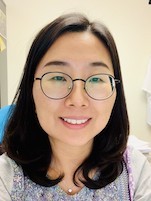
BACKGROUND
Dr.Park received her Ph.D. Microbiology from Ewha Womans University (Seoul, Korea) in 2002, followed by postdoctoral training in mycology and molecular biology at the Division of Infectious Diseases, Harbor-UCLA Medical Center. Dr. Park joined the Department of Biological Sciences at Cal State LA in 2008.
TEACHING INTERESTS
Dr. Park teaches MICR 3100 General Microbiology, BIOL 4160 Molecular Genetics, and MICR 4400 Mycology courses for undergraduate students and offers Seminar: Microbiology and Immunology for graduate students. In addition, she provides research training to the students in the Department of Biological Sciences.
RESEARCH
-
The molecular mechanism of environmental sensing by fungal microflora and fungal adaptation to different host cells and disease development.
-
Transcriptome and metabolomic analysis of casein kinase I mutant strain during C. albicans-host cell interaction by RNA-seq analysis.
-
Defining functional lineage of casein kinase I orthologs of C. albicans and in other fungal species.
PUBLICATIONS
-
K. Liboro, S.-R. Yu, J. Lim, Y.-S. So, Y.-S. Bahn, H. Eoh, H. Park. Transcriptomic and Metabolomic Analysis Revealed Roles of Yck2 in Carbon Metabolism and Morphogenesis of Candida albicans. Frontiers Cell. Infect. Micro. 2021.
-
K. R. Parducho, B. Beadell, T. Ybarra, M. Bush, E. Escalera, A. T. Trejos, A. Chieng, M. Mendez, C. Anderson, H. Park, Y. Wang, W. Lu, and E. Porter. The Antimicrobial Peptide Human Beta-Defensin 2 Inhibits Biofilm Production of Pseudomonas aeruginosa without Compromising Metabolic Activity. Frontiers Immunology. 8;11:805. 2020.
-
S.-I. Jung, N. Rodriguez, J. Irrizary, K. Liboro, M. Macias, T. Bogarin, E. Porter, E. Eivers, S.G. Filler,and H. Park. Yeast casein kinase 2 plays an important role in governing morphology, stress response, and cell integrity of Candida albicans. PLOS ONE, 2017.
-
Park H, Solis N, Louie J, Spellberg B, Rodriguez N, and Filler SG. Different tumor necrosis factor α antagonists have different effects on host susceptibility to disseminated and oropharyngeal candidiasis in mice. Virulence 5:5, 1-5, 2014.
-
Phan QT, Eng DK, Mostowy S, Park H, Cossart P, and Filler SG. Role of Endothelial Cell Septin 7 in the Endocytosis of Candida albicans. M. Bio 4(6) 542-13, 2013.
-
Park H, Liu Y, Solis N, Spotkov J, Hamaker J, Blankenship JR, Yeaman MR, Mitchell AP, Liu H and Filler SG. Transcriptional responses of Candida albicans to epithelial and endothelial cells. Eukaryotic Cell 8:1498-1510, 2009.
-
Gank KD, Yeaman MR, Kojima S, Yount NY, Park H, Edwards, Jr. JE, Filler SG, and Fu Y. SSD1 is Integral to Host Defense Peptide Resistance in Candida albicans. Eukaryot Cell 7(8):1318-1327, 2008.
-
Barker KS, Park H, Phan QT, Xu L, Homayouni R, Rogers PD, Filler SG. Transcriptome Profile of the Vascular Endothelial Cell Response to Candida albicans. J. Infect Dis. 198:193–202 (Equally contributed first author), 2008.
-
Goyard S, Knechtle P, Chauvel M, Mallet A, Prévost MC, Proux C, Coppée JY, Schwartz P, Dromer F, Park H, Filler SG, Janbon G, d'Enfert C. The Yak1 Kinase is Involved in the Initiation and Maintenance of Hyphal Growth in Candida albicans. Mol Biol Cell.19(5), 2251-2266, 2008.
-
Thewes S, Kretschmar M, Park H, Schaller M, Filler SG, Hube B. In vivo and ex vivo comparative transcriptional profiling of invasive and non-invasive Candida albicans isolates identifies genes associated with tissue invasion. Mol Microbiol. 2007 Mar;63(6):1606-28, 2007.
-
Martinez-Lopez R, Park H, Myers CL, Gil C, Filler SG. Candida albicans Ecm33p is important for normal cell wall architecture and interactions with host cells. Eukaryot Cell. 2006 Jan;5(1):140-7, 2006.
-
Park H, Myers CL, Sheppard DC, Phan QT, Sanchez AA, E Edwards J, Filler SG. Role of the fungal Ras-protein kinase A pathway in governing epithelial cell interactions during oropharyngeal candidiasis. Cell Microbiol. 2005 Apr;7(4):499-510, 2005.
-
Choi S, Park N, Park H, Park M, Woo J, Choi W Interacting domain between yeast chitin synthase 3 and chitin synthase 4 is involved in angiogenesis of chitin ring, but not for cell wall chitin. J Microbiol Biotechnol 13:263-268, 2003.
-
Park H, Choi S, Park N, Kim C, Kim S, Choi W Identification of a domain in yeast chitin synthase 3 interacting with chitin synthase 4 by two hybrid analysis. J Microbiol Biotechnol 12:943-949, 2002.
-
Kim M, Park H, C Kim, Park H, Choi W Inhibition of chitin synthases by nikkomycin is dependent on media composition in Candida albicans. Yeast 19:341-349, 2002.
-
Min J, Lee Y, Kim Y, Park H, Han S, Jhon G-J, Choi W Lysophosphatidylcholine derived from deer antler extract suppresses hyphal transition in Candida albicans through MAP kinase activity. Biochim Biophysica Acta 1531:77-89, 2001.
-
Park H, Jhon G-J, Choi W Hyphal growth inhibition by deer antler extract mimics the effect of chitin synthase deletion in Candida albicans. J Microbiol Biotechnol 8:422-425, 1998.
-
Park H, John G-J, Choi W 1998 Deer antler extract selectively suppresses hyphal growth in dimorphic fungus, Candida albicans. J Microbiol Biotechnol 8:291-294, 1998.
EDUCATIONAL BACKGROUND
-
Ph.D. Microbiology (emphasis in mycology and molecular biology) 2002 - Ewha Womans University, Korea
-
M.S. Microbiology 1998 - Ewha Womans University, Seoul Korea
-
B.S. Biology ( Minor: science Education) 1996 - Ewha Womans University, Korea